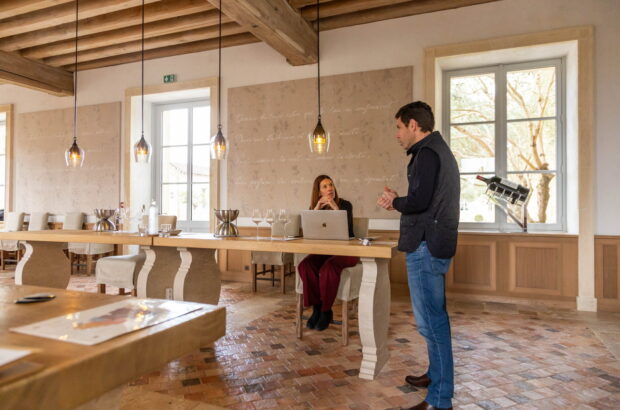Stumped by the price of a particularly famous château in St-Emilion or Pomerol? Attracted by the style and execution but know the wine is out of reach? There may be a solution.
A number of these grand estates also own properties in less exalted appellations, often using the same team and work practices as they do at the top estate. The wines, therefore, have a defined quality, but the bonus is they sell at a much more affordable price.
See tasting notes and scores for six top St-Emilion and Pomerol ‘second site’ picks
The most usual reasons for the acquisition of a secondary estate (or estates) are diversification and expansion into a more affordable region, land-wise.
With prices per hectare popping in St-Emilion and Pomerol, the likes of Castillon, Lalande de Pomerol, the St-Emilion satellites and even parts of Entre-deux-Mers can look highly attractive.
There can also be a sentimental stimulus and, when it comes to a key figure running the great estate, the motivation of a more personalised project.
{"content":"PHA+Q29tZSB3aGF0IG1heSwgdGhlIOKAmG90aGVy4oCZIHByb3BlcnR5LCB3aGljaCwgZ2VvZ3JhcGhpY2FsbHkgc3BlYWtpbmcsIGlzIHJhcmVseSBzaXR1YXRlZCBmYXIgZnJvbSBpdHMgY2VsZWJyYXRlZCBzdGFibGVtYXRlLCBpcyBhbiBpbnRlcmVzdGluZyBvcHRpb24gZm9yIHRoZSBkaXNjZXJuaW5nIGNvbnN1bWVyLjwvcD4KPHA+Tm8sIGl0IHdvbuKAmXQgaGF2ZSBxdWl0ZSB0aGUgcGVkaWdyZWUgYW5kIGdyYXZpdGFzIG9mIHRoZSB0b3AgZXN0YXRlICh0aGUgZWxlbWVudCBvZiB0ZXJyb2lyIGRvZXMgY29tZSBpbnRvIHBsYXkpLCBidXQgaXQgd2lsbCBoYXZlIHRoZSBzYW1lIHdpbmVtYWtpbmcgcGhpbG9zb3BoeSBhbmQgcmlnb3VyLCB0aGUgZGVzaXJlIGZvciBxdWFsaXR5IGFuZCBhdXRoZW50aWNpdHkgdXBwZXJtb3N0LjwvcD4KPGhyPgo8aDM+Q2jDonRlYXUgSGF1dC1TaW1hcmQgJiM4MjExOyBTdC1FbWlsaW9uIEdyYW5kIENydTwvaDM+CjxwPlRoaXMgaXMgb25lIG9mIHNldmVyYWwgcHJvcGVydGllcyBvd25lZCBieSB0aGUgVmF1dGhpZXIgZmFtaWx5LCB0aGUgamV3ZWwgaW4gdGhlIGNyb3duIGJlaW5nIENow6J0ZWF1IEF1c29uZS4gQW5kIHllcywgaXQgaXMgYWxzbyBsb2NhdGVkIGluIFN0LUVtaWxpb24sIG5vdCB0aGF0IGZhciBmcm9tIEF1c29uZSBidXQgbG93ZXIgZG93biBvbiB0aGUgc2FuZCBhbmQgY2xheSBzb2lscyBhdCB0aGUgZm9vdCBvZiB0aGUgaGlsbCwgb3IgcGllZCBkZSBjw7R0ZSwgYmVsb3cgdGhlIHRvd24gaXRzZWxmLjwvcD4KPGRpdiBjbGFzcz0iYWQtY29udGFpbmVyIGFkLWNvbnRhaW5lci0tbW9iaWxlIj48ZGl2IGlkPSJwb3N0LWlubGluZS0zIiBjbGFzcz0iaXBjLWFkdmVydCI+PC9kaXY+PC9kaXY+CjxwPkluIHRoZSAxODYwcywgdGhlIFNpbWFyZCB2aW5leWFyZCB3YXMgc3BsaXQgaW4gdHdvIGJ5IHRoZSBjb25zdHJ1Y3Rpb24gb2YgYSByYWlsd2F5IGxpbmUsIGNyZWF0aW5nIHR3byBzZXBhcmF0ZSBwcm9wZXJ0aWVzLCBTaW1hcmQgYW5kIEhhdXQtU2ltYXJkLiBUaGV5IHdlcmUgbGF0ZXIgcmV1bml0ZWQgYW5kIGFyZSBub3cgYm90aCBvd25lZCBieSB0aGUgVmF1dGhpZXIgZmFtaWx5LjwvcD4KPGRpdiBpZD0iYXR0YWNobWVudF80NjE3OTgiIHN0eWxlPSJ3aWR0aDogNjQwcHgiIGNsYXNzPSJ3cC1jYXB0aW9uIGFsaWdubm9uZSI+PGltZyBmZXRjaHByaW9yaXR5PSJoaWdoIiBkZWNvZGluZz0iYXN5bmMiIGFyaWEtZGVzY3JpYmVkYnk9ImNhcHRpb24tYXR0YWNobWVudC00NjE3OTgiIGNsYXNzPSJsYXp5bG9hZCBibHVyLXVwIHNpemUtbGFyZ2Ugd3AtaW1hZ2UtNDYxNzk4IiBkYXRhLXByb2Nlc3NlZCBzcmM9Imh0dHBzOi8vd3d3LmRlY2FudGVyLmNvbS93cC1jb250ZW50L3RoZW1lcy9zaW1iYS10aGVtZS9hc3NldHMvaW1hZ2VzL3BsYWNlaG9sZGVyLnBuZyIgZGF0YS1zcmM9Imh0dHBzOi8va2V5YXNzZXRzLnRpbWVpbmN1ay5uZXQvaW5zcGlyZXdwL2xpdmUvd3AtY29udGVudC91cGxvYWRzL3NpdGVzLzM0LzIwMjEvMDYvUGF1bGluZS1WYXV0aGllci02MzB4NDIwLmpwZyIgYWx0PSJQYXVsaW5lIFZhdXRoaWVyIiB3aWR0aD0iNjMwIiBoZWlnaHQ9IjQyMCIgZGF0YS1zaXplcz0iYXV0byIgZGF0YS1zcmNzZXQ9Imh0dHBzOi8va2V5YXNzZXRzLnRpbWVpbmN1ay5uZXQvaW5zcGlyZXdwL2xpdmUvd3AtY29udGVudC91cGxvYWRzL3NpdGVzLzM0LzIwMjEvMDYvUGF1bGluZS1WYXV0aGllci02MzB4NDIwLmpwZyA2MzB3LCBodHRwczovL2tleWFzc2V0cy50aW1laW5jdWsubmV0L2luc3BpcmV3cC9saXZlL3dwLWNvbnRlbnQvdXBsb2Fkcy9zaXRlcy8zNC8yMDIxLzA2L1BhdWxpbmUtVmF1dGhpZXItMzAweDIwMC5qcGcgMzAwdywgaHR0cHM6Ly9rZXlhc3NldHMudGltZWluY3VrLm5ldC9pbnNwaXJld3AvbGl2ZS93cC1jb250ZW50L3VwbG9hZHMvc2l0ZXMvMzQvMjAyMS8wNi9QYXVsaW5lLVZhdXRoaWVyLTEzNXg5MC5qcGcgMTM1dywgaHR0cHM6Ly9rZXlhc3NldHMudGltZWluY3VrLm5ldC9pbnNwaXJld3AvbGl2ZS93cC1jb250ZW50L3VwbG9hZHMvc2l0ZXMvMzQvMjAyMS8wNi9QYXVsaW5lLVZhdXRoaWVyLTMyMHgyMTMuanBnIDMyMHcsIGh0dHBzOi8va2V5YXNzZXRzLnRpbWVpbmN1ay5uZXQvaW5zcGlyZXdwL2xpdmUvd3AtY29udGVudC91cGxvYWRzL3NpdGVzLzM0LzIwMjEvMDYvUGF1bGluZS1WYXV0aGllci02MjB4NDE0LmpwZyA2MjB3LCBodHRwczovL2tleWFzc2V0cy50aW1laW5jdWsubmV0L2luc3BpcmV3cC9saXZlL3dwLWNvbnRlbnQvdXBsb2Fkcy9zaXRlcy8zNC8yMDIxLzA2L1BhdWxpbmUtVmF1dGhpZXIuanBnIDcwMHciIHNpemVzPSIobWF4LXdpZHRoOiA2MzBweCkgMTAwdncsIDYzMHB4IiAvPjxwIGlkPSJjYXB0aW9uLWF0dGFjaG1lbnQtNDYxNzk4IiBjbGFzcz0id3AtY2FwdGlvbi10ZXh0Ij5QYXVsaW5lIFZhdXRoaWVyPC9wPjwvZGl2Pgo8ZGl2IGNsYXNzPSJhZC1jb250YWluZXIgYWQtY29udGFpbmVyLS1tb2JpbGUiPjxkaXYgaWQ9InBvc3QtaW5saW5lLTQiIGNsYXNzPSJpcGMtYWR2ZXJ0Ij48L2Rpdj48L2Rpdj4KPHA+VGhlIHByZXNlbnQgaWRlbnRpdHkgb2YgQ2jDonRlYXUgSGF1dC1TaW1hcmQsIHRob3VnaCwgZGF0ZXMgZnJvbSB0aGUgZWFybHkgcGFydCBvZiB0aGUgbmV3IG1pbGxlbm5pdW0sIHdoZW4gQWxhaW4gVmF1dGhpZXIgc2VsZWN0ZWQgc3BlY2lmaWMgcGFyY2VscyB0byBiZSBwbGFudGVkIHRvIGEgZGVuc2l0eSBvZiAxMiwwMDAgdmluZXMvaGEgd2l0aCBhIG1ham9yaXR5IDxhIGhyZWY9Imh0dHBzOi8vd3d3LmRlY2FudGVyLmNvbS93aW5lL2dyYXBlLXZhcmlldGllcy9jYWJlcm5ldC1mcmFuYy8iPjxzdHJvbmc+Q2FiZXJuZXQgRnJhbmM8L3N0cm9uZz4gPC9hPig2MCUpLiBUaGUgdmluZXlhcmQgbm93IGNvbXByaXNlcyAxMGhhIHByb2R1Y2luZyAzNSwwMDAtNDAsMDAwIGJvdHRsZXMgYSB5ZWFyLjwvcD4KPHA+VGhlIHNhbWUgdGVhbSwgaGVhZGVkIGJ5IEFsYWlu4oCZcyBkYXVnaHRlciBQYXVsaW5lLCB3b3JrcyBBdXNvbmUgYW5kIEhhdXQtU2ltYXJkIChhcyB3ZWxsIGFzIHRoZSBvdGhlciBwcm9wZXJ0aWVzKSwgYXBwbHlpbmcgc2ltaWxhciB0ZWNobmlxdWVzOiBjYXJlIGluIHRoZSB2aW5leWFyZCwgcmVmcmFpbmluZyBmcm9tIG92ZXJyaXBlbmVzcywgZ2VudGxlIGV4dHJhY3Rpb24gYW5kIGEgbGlnaHQgdG91Y2ggd2l0aCBvYWsgYWdlaW5nLjwvcD4KPGRpdiBjbGFzcz0iYWQtY29udGFpbmVyIGFkLWNvbnRhaW5lci0tbW9iaWxlIj48ZGl2IGlkPSJwb3N0LWlubGluZS01IiBjbGFzcz0iaXBjLWFkdmVydCI+PC9kaXY+PC9kaXY+CjxwPldpdGggcmVsYXRpdmVseSB5b3VuZyB2aW5lcywgSGF1dC1TaW1hcmQgaGFzIGFscmVhZHkgYWNxdWlyZWQgYWRkZWQgZGVwdGggYW5kIHN0cnVjdHVyZSBhbmQsIGF0IGFib3V0IMKjMjAtwqMyNSBhIGJvdHRsZSwgbG9va3MgYW4gYXR0cmFjdGl2ZSBidXkgY29tcGFyZWQgdG8gQXVzb25l4oCZcyDCozYwMC48L3A+Cjxocj4KPGgzPkNow6J0ZWF1IExlcyBDcnV6ZWxsZXMgJiM4MjExOyBMYWxhbmRlIGRlIFBvbWVyb2w8L2gzPgo8cD5UaGUgbGF0ZSBEZW5pcyBEdXJhbnRvdSBhY3F1aXJlZCAxMWhhIENow6J0ZWF1IExlcyBDcnV6ZWxsZXMgaW4gMjAwMC4g4oCYRGVuaXMgYWx3YXlzIHdhbnRlZCB0byBtYWtlIHdpbmUgaW4gTGFsYW5kZSBkZSBQb21lcm9sIGFzIGhpcyBncmVhdC1ncmFuZGZhdGhlciB1c2VkIHRvIG93biBhIHByb3BlcnR5IHRoZXJlLCBidXQgaXQgd2FzIHNvbGQgdG8ga2VlcCBM4oCZRWdsaXNlLUNsaW5ldCBpbiBvdXIgZmFtaWx5IGhhbmRzLOKAmSBleHBsYWlucyBEZW5pc+KAmSBkYXVnaHRlciBOb8OrbWllLjwvcD4KPHA+QnkgdGhlbiwgRHVyYW50b3UgaGFkIGFscmVhZHkgbWFkZSBzb21ldGhpbmcgb2YgYSByZXB1dGF0aW9uLCBlbGV2YXRpbmcgTOKAmUVnbGlzZS1DbGluZXQgaW50byB0aGUgaGlnaGVyIGVjaGVsb25zIG9mIHRoZSBQb21lcm9sIGFwcGVsbGF0aW9uLiBOZWVkbGVzcyB0byBzYXksIGhlIGVtYmFya2VkIG9uIHRoZSBjb252ZXJzaW9uIG9mIExlcyBDcnV6ZWxsZXMgaW4gdGhlIHNhbWUgZmFzdGlkaW91cyBtYW5uZXIuPC9wPgo8ZGl2IGlkPSJhdHRhY2htZW50XzQ2MTgwMSIgc3R5bGU9IndpZHRoOiA2NDBweCIgY2xhc3M9IndwLWNhcHRpb24gYWxpZ25ub25lIj48aW1nIGRlY29kaW5nPSJhc3luYyIgYXJpYS1kZXNjcmliZWRieT0iY2FwdGlvbi1hdHRhY2htZW50LTQ2MTgwMSIgY2xhc3M9Imxhenlsb2FkIGJsdXItdXAgc2l6ZS1sYXJnZSB3cC1pbWFnZS00NjE4MDEiIGRhdGEtcHJvY2Vzc2VkIHNyYz0iaHR0cHM6Ly93d3cuZGVjYW50ZXIuY29tL3dwLWNvbnRlbnQvdGhlbWVzL3NpbWJhLXRoZW1lL2Fzc2V0cy9pbWFnZXMvcGxhY2Vob2xkZXIucG5nIiBkYXRhLXNyYz0iaHR0cHM6Ly9rZXlhc3NldHMudGltZWluY3VrLm5ldC9pbnNwaXJld3AvbGl2ZS93cC1jb250ZW50L3VwbG9hZHMvc2l0ZXMvMzQvMjAyMS8wNi9DaGF0ZWF1LUxlcy1DcnV6ZWxsZXMtNjMweDYyMy5qcGciIGFsdD0iQ2jDonRlYXUgTGVzIENydXplbGxlcyIgd2lkdGg9IjYzMCIgaGVpZ2h0PSI2MjMiIGRhdGEtc2l6ZXM9ImF1dG8iIGRhdGEtc3Jjc2V0PSJodHRwczovL2tleWFzc2V0cy50aW1laW5jdWsubmV0L2luc3BpcmV3cC9saXZlL3dwLWNvbnRlbnQvdXBsb2Fkcy9zaXRlcy8zNC8yMDIxLzA2L0NoYXRlYXUtTGVzLUNydXplbGxlcy02MzB4NjIzLmpwZyA2MzB3LCBodHRwczovL2tleWFzc2V0cy50aW1laW5jdWsubmV0L2luc3BpcmV3cC9saXZlL3dwLWNvbnRlbnQvdXBsb2Fkcy9zaXRlcy8zNC8yMDIxLzA2L0NoYXRlYXUtTGVzLUNydXplbGxlcy0zMDB4Mjk3LmpwZyAzMDB3LCBodHRwczovL2tleWFzc2V0cy50aW1laW5jdWsubmV0L2luc3BpcmV3cC9saXZlL3dwLWNvbnRlbnQvdXBsb2Fkcy9zaXRlcy8zNC8yMDIxLzA2L0NoYXRlYXUtTGVzLUNydXplbGxlcy0xMzV4MTMzLmpwZyAxMzV3LCBodHRwczovL2tleWFzc2V0cy50aW1laW5jdWsubmV0L2luc3BpcmV3cC9saXZlL3dwLWNvbnRlbnQvdXBsb2Fkcy9zaXRlcy8zNC8yMDIxLzA2L0NoYXRlYXUtTGVzLUNydXplbGxlcy0zMjB4MzE2LmpwZyAzMjB3LCBodHRwczovL2tleWFzc2V0cy50aW1laW5jdWsubmV0L2luc3BpcmV3cC9saXZlL3dwLWNvbnRlbnQvdXBsb2Fkcy9zaXRlcy8zNC8yMDIxLzA2L0NoYXRlYXUtTGVzLUNydXplbGxlcy02MjB4NjEzLmpwZyA2MjB3LCBodHRwczovL2tleWFzc2V0cy50aW1laW5jdWsubmV0L2luc3BpcmV3cC9saXZlL3dwLWNvbnRlbnQvdXBsb2Fkcy9zaXRlcy8zNC8yMDIxLzA2L0NoYXRlYXUtTGVzLUNydXplbGxlcy5qcGcgODAwdyIgc2l6ZXM9IihtYXgtd2lkdGg6IDYzMHB4KSAxMDB2dywgNjMwcHgiIC8+PHAgaWQ9ImNhcHRpb24tYXR0YWNobWVudC00NjE4MDEiIGNsYXNzPSJ3cC1jYXB0aW9uLXRleHQiPkNow6J0ZWF1IExlcyBDcnV6ZWxsZXM8L3A+PC9kaXY+CjxwPlRoZSB2aW5leWFyZCB3YXMgcmVwbGFudGVkIGluIDIwMDQgYW5kIDIwMDksIGFsbG93aW5nIHRoZSB2aW5lcyB0byBiZSBhbGlnbmVkIG5vcnRoLXNvdXRoIGFuZCBhdCBhIGRlbnNpdHkgb2YgOCwzMzMgdmluZXMvaGEsIHdpdGggbWFzc2FsIHNlbGVjdGlvbiBDYWJlcm5ldCBGcmFuYyBmcm9tIEzigJlFZ2xpc2UtQ2xpbmV0IChwcm9wYWdhdGVkIGJ5IHRha2luZyBjdXR0aW5ncyBmcm9tIHRoZSBiZXN0LXF1YWxpdHkgZXhpc3RpbmcgdmluZXMgb24gYSBnaXZlbiBzaXRlKSB1c2VkIGZvciBzb21lIG9mIHRoZSBwbGFudGluZ3MuPC9wPgo8cD5MZXMgQ3J1emVsbGVzIGlzIG5vdyBwcm9kdWNlZCBmcm9tIHRoZSBvbGRlciB2aW5lcyAob24gZ3JhdmVsbHkgc29pbHMpLCB3aGlsZSBMYSBDaGVuYWRlIGNvbWVzIGZyb20gdGhlIHlvdW5nZXIgcGxhbnRpbmdzIGFuZCB0aG9zZSBvbiBzYW5kaWVyIHNvaWxzLiDigJhXZSBhcHBseSB0aGUgc2FtZSBhcHByb2FjaCBhcyBmb3IgdGhlIGdyYW5kcyBjcnVzLCBidXQgd2FudCB0aGUgd2luZXMgdG8gcmVtYWluIGFmZm9yZGFibGUgdG8gdGhlIGNvbnN1bWVyLOKAmSBzYXlzIE5vw6ttaWUsIHdobyBoYXMgbm93IHRha2VuIG92ZXIgdGhlIHdpbmVtYWtpbmcgYWxvbmdzaWRlIGxvbmctdGltZSBjZWxsYXIgbWFzdGVyIE9saXZpZXIgR2F1dHJhdC48L3A+Cjxocj4KPGgzPkNow6J0ZWF1IGTigJlBaWd1aWxoZSAmIzgyMTE7IENhc3RpbGxvbiBDw7R0ZXMgZGUgQm9yZGVhdXg8L2gzPgo8cD5UaGUgdm9uIE5laXBwZXJnIGZhbWlseSBvd25zIGFuIGVudmlhYmxlIGhpZXJhcmNoeSBvZiBwcm9wZXJ0aWVzIG9uIHRoZSBSaWdodCBCYW5rOiBDaMOidGVhdXggQ2Fub24gTGEgR2FmZmVsacOocmUgYW5kIExhIE1vbmRvdHRlIChib3RoIFN0LUVtaWxpb24gMUdDQ3MpLCBDbG9zIGRlIGzigJlPcmF0b2lyZSAoU3QtRW1pbGlvbiBHQ0MpIGFuZCwgZmluYWxseSwgQWlndWlsaGUgaW4gQ2FzdGlsbG9uLiBUaGUgbGF0dGVyIG1heSBiZSBsYXN0IGluIHRoZSBwZWNraW5nIG9yZGVyLCBidXQgd2l0aCBhIHRvdGFsIG9mIDE1MGhhIGluY2x1ZGluZyB3b29kcywgcGFzdHVyZSBhbmQgODVoYSBvZiB2aW5leWFyZCwgaXQgaXMgYW55dGhpbmcgYnV0IGluc2lnbmlmaWNhbnQuPC9wPgo8cD5XaGVuIFN0ZXBoYW4gdm9uIE5laXBwZXJnIGFjcXVpcmVkIEFpZ3VpbGhlIGluIDE5OTgsIHRoZXJlIHdlcmUgdGhyZWUgdGhpbmdzIHRoYXQgYXR0cmFjdGVkIGhpbSB0byB0aGUgc2l0ZTog4oCYVGhlIGNsYXktbGltZXN0b25lIHNvaWxzIGluZGljYXRlZCBhIHByb21pc2luZyB2aXRpY3VsdHVyYWwgdGVycm9pciwgdGhlIHByaWNlIG9mIHRoZSBsYW5kIHdhcyBhdHRyYWN0aXZlIGFuZCB0aGVyZSB3YXMgYW4gaW50ZXJlc3RpbmcgaGlzdG9yaWNhbCBhc3BlY3QgYXMgdGhlIHByb3BlcnR5LCB3aG9zZSBjaMOidGVhdSBkYXRlcyBmcm9tIHRoZSAxM3RoIGNlbnR1cnksIGhhZCBhIHN0cmF0ZWdpYyBpbXBvcnRhbmNlIGR1cmluZyB0aGUgSHVuZHJlZCBZZWFyc+KAmSBXYXIs4oCZIGhlIHJlY291bnRzLjwvcD4KPGRpdiBpZD0iYXR0YWNobWVudF80NjE3OTYiIHN0eWxlPSJ3aWR0aDogNjQwcHgiIGNsYXNzPSJ3cC1jYXB0aW9uIGFsaWdubm9uZSI+PGltZyBkZWNvZGluZz0iYXN5bmMiIGFyaWEtZGVzY3JpYmVkYnk9ImNhcHRpb24tYXR0YWNobWVudC00NjE3OTYiIGNsYXNzPSJsYXp5bG9hZCBibHVyLXVwIHNpemUtbGFyZ2Ugd3AtaW1hZ2UtNDYxNzk2IiBkYXRhLXByb2Nlc3NlZCBzcmM9Imh0dHBzOi8vd3d3LmRlY2FudGVyLmNvbS93cC1jb250ZW50L3RoZW1lcy9zaW1iYS10aGVtZS9hc3NldHMvaW1hZ2VzL3BsYWNlaG9sZGVyLnBuZyIgZGF0YS1zcmM9Imh0dHBzOi8va2V5YXNzZXRzLnRpbWVpbmN1ay5uZXQvaW5zcGlyZXdwL2xpdmUvd3AtY29udGVudC91cGxvYWRzL3NpdGVzLzM0LzIwMjEvMDYvU3RlcGhhbi12b24tTmVpcHBlcmctNjMweDQ5Mi5qcGciIGFsdD0iU3RlcGhhbiB2b24gTmVpcHBlcmciIHdpZHRoPSI2MzAiIGhlaWdodD0iNDkyIiBkYXRhLXNpemVzPSJhdXRvIiBkYXRhLXNyY3NldD0iaHR0cHM6Ly9rZXlhc3NldHMudGltZWluY3VrLm5ldC9pbnNwaXJld3AvbGl2ZS93cC1jb250ZW50L3VwbG9hZHMvc2l0ZXMvMzQvMjAyMS8wNi9TdGVwaGFuLXZvbi1OZWlwcGVyZy02MzB4NDkyLmpwZyA2MzB3LCBodHRwczovL2tleWFzc2V0cy50aW1laW5jdWsubmV0L2luc3BpcmV3cC9saXZlL3dwLWNvbnRlbnQvdXBsb2Fkcy9zaXRlcy8zNC8yMDIxLzA2L1N0ZXBoYW4tdm9uLU5laXBwZXJnLTMwMHgyMzQuanBnIDMwMHcsIGh0dHBzOi8va2V5YXNzZXRzLnRpbWVpbmN1ay5uZXQvaW5zcGlyZXdwL2xpdmUvd3AtY29udGVudC91cGxvYWRzL3NpdGVzLzM0LzIwMjEvMDYvU3RlcGhhbi12b24tTmVpcHBlcmctMTM1eDEwNS5qcGcgMTM1dywgaHR0cHM6Ly9rZXlhc3NldHMudGltZWluY3VrLm5ldC9pbnNwaXJld3AvbGl2ZS93cC1jb250ZW50L3VwbG9hZHMvc2l0ZXMvMzQvMjAyMS8wNi9TdGVwaGFuLXZvbi1OZWlwcGVyZy0zMjB4MjUwLmpwZyAzMjB3LCBodHRwczovL2tleWFzc2V0cy50aW1laW5jdWsubmV0L2luc3BpcmV3cC9saXZlL3dwLWNvbnRlbnQvdXBsb2Fkcy9zaXRlcy8zNC8yMDIxLzA2L1N0ZXBoYW4tdm9uLU5laXBwZXJnLTYyMHg0ODQuanBnIDYyMHcsIGh0dHBzOi8va2V5YXNzZXRzLnRpbWVpbmN1ay5uZXQvaW5zcGlyZXdwL2xpdmUvd3AtY29udGVudC91cGxvYWRzL3NpdGVzLzM0LzIwMjEvMDYvU3RlcGhhbi12b24tTmVpcHBlcmcuanBnIDgwMHciIHNpemVzPSIobWF4LXdpZHRoOiA2MzBweCkgMTAwdncsIDYzMHB4IiAvPjxwIGlkPSJjYXB0aW9uLWF0dGFjaG1lbnQtNDYxNzk2IiBjbGFzcz0id3AtY2FwdGlvbi10ZXh0Ij5TdGVwaGFuIHZvbiBOZWlwcGVyZzwvcD48L2Rpdj4KPHA+TWV0aG9kcyBvZiB2aW5pZmljYXRpb24gaGF2ZSBiZWVuIGFkYXB0ZWQgdG8gdGhlIHRlcnJvaXIsIGEgbmV3IGNpcmN1bGFyIGNlbGxhciBiYXB0aXNlZCBpbiAyMDAzIGFuZCBzaW5jZSBleHRlbmRlZCwgYnV0IEFpZ3VpbGhlIGFsc28gYmVuZWZpdHMgZnJvbSB0aGUgY29oZXNpb24gd2l0aCB0aGUgb3RoZXIgZXN0YXRlcy4gQWxsIGFyZSBtYW5hZ2VkIGJ5IHRoZSBzYW1lIHRlYW0sIHdpdGggQWlndWlsaGUgc3VwcGx5aW5nIHRoZSBjb21wb3N0IGZvciBhbGwgYW5kIGFjdGluZyBhcyBhIGNvbnNlcnZhdG9yeSBmb3IgdGhlIG1hc3NhbCBzZWxlY3Rpb24gdmluZXMuIFRoZSB3aW5lIGl0c2VsZiwgd2hpY2ggaGFzYm90aCBmcnVpdCBhbmQgcG93ZXIgYW5kIGFuIGFnZWluZyBwb3RlbnRpYWwgb2YgMjAgeWVhcnMsIGlzIG9uZSBvZiB0aGUgYmVzdC12YWx1ZSBpbkJvcmRlYXV4IHRvZGF5LjwvcD4KPGhyPgo8aDM+TOKAmSBIw6p0cmUgJiM4MjExOyBDYXN0aWxsb24gQ8O0dGVzIGRlIEJvcmRlYXV4PC9oMz4KPHA+VGhpcyBpcyB0aGUgbGF0ZXN0IHZlbnR1cmUgb2YgSmFjcXVlcyBUaGllbnBvbnQgb2YgQ2jDonRlYXUgTGUgUGluIGluIFBvbWVyb2wuIEluIDIwMTYsIGhlIGFuZCBoaXMgc2lzdGVyLCBBbm5lIERlIFJhZXltYWVrZXIsIGFjcXVpcmVkIHdoYXQgd2FzIHRoZW4gY2FsbGVkIENow6J0ZWF1IEdvdWJhdSBhdCBHYXJkZWdhbi1ldC1Ub3VydGlyYWMgYW5kIGNoYW5nZWQgdGhlIG5hbWUgdG8gTOKAmUjDqnRyZSAo4oCYYmVlY2ggdHJlZeKAmSkgdG8gcGVycGV0dWF0ZSB0aGUgdHJlZS1pbnNwaXJlZCBtb25pa2VyIOKAkyBhcGFydCBmcm9tIExlIFBpbiAo4oCYcGluZSB0cmVl4oCZKSx0aGVyZeKAmXMgYWxzbyBM4oCZSWYsIG9yIOKAmHlldyB0cmVl4oCZLCBpbiBTdC1FbWlsaW9uLiBXaGF0IGF0dHJhY3RlZCB0aGVtIHdhcyB0aGUgMTBoYSB2aW5leWFyZG9uIGEgbGltZXN0b25lIHBsYXRlYXUuPC9wPgo8ZGl2IGlkPSJhdHRhY2htZW50XzQ2MTgwMCIgc3R5bGU9IndpZHRoOiA1NjZweCIgY2xhc3M9IndwLWNhcHRpb24gYWxpZ25ub25lIj48aW1nIGxvYWRpbmc9ImxhenkiIGRlY29kaW5nPSJhc3luYyIgYXJpYS1kZXNjcmliZWRieT0iY2FwdGlvbi1hdHRhY2htZW50LTQ2MTgwMCIgY2xhc3M9Imxhenlsb2FkIGJsdXItdXAgc2l6ZS1sYXJnZSB3cC1pbWFnZS00NjE4MDAiIGRhdGEtcHJvY2Vzc2VkIHNyYz0iaHR0cHM6Ly93d3cuZGVjYW50ZXIuY29tL3dwLWNvbnRlbnQvdGhlbWVzL3NpbWJhLXRoZW1lL2Fzc2V0cy9pbWFnZXMvcGxhY2Vob2xkZXIucG5nIiBkYXRhLXNyYz0iaHR0cHM6Ly9rZXlhc3NldHMudGltZWluY3VrLm5ldC9pbnNwaXJld3AvbGl2ZS93cC1jb250ZW50L3VwbG9hZHMvc2l0ZXMvMzQvMjAyMS8wNi9KYWNxdWVzLVRoaWVucG9udC01NTZ4ODMwLmpwZyIgYWx0PSJKYWNxdWVzIFRoaWVucG9udCIgd2lkdGg9IjU1NiIgaGVpZ2h0PSI4MzAiIGRhdGEtc2l6ZXM9ImF1dG8iIGRhdGEtc3Jjc2V0PSJodHRwczovL2tleWFzc2V0cy50aW1laW5jdWsubmV0L2luc3BpcmV3cC9saXZlL3dwLWNvbnRlbnQvdXBsb2Fkcy9zaXRlcy8zNC8yMDIxLzA2L0phY3F1ZXMtVGhpZW5wb250LTU1Nng4MzAuanBnIDU1NncsIGh0dHBzOi8va2V5YXNzZXRzLnRpbWVpbmN1ay5uZXQvaW5zcGlyZXdwL2xpdmUvd3AtY29udGVudC91cGxvYWRzL3NpdGVzLzM0LzIwMjEvMDYvSmFjcXVlcy1UaGllbnBvbnQtMzAweDQ0OC5qcGcgMzAwdywgaHR0cHM6Ly9rZXlhc3NldHMudGltZWluY3VrLm5ldC9pbnNwaXJld3AvbGl2ZS93cC1jb250ZW50L3VwbG9hZHMvc2l0ZXMvMzQvMjAyMS8wNi9KYWNxdWVzLVRoaWVucG9udC05MHgxMzUuanBnIDkwdywgaHR0cHM6Ly9rZXlhc3NldHMudGltZWluY3VrLm5ldC9pbnNwaXJld3AvbGl2ZS93cC1jb250ZW50L3VwbG9hZHMvc2l0ZXMvMzQvMjAyMS8wNi9KYWNxdWVzLVRoaWVucG9udC0yMTR4MzIwLmpwZyAyMTR3LCBodHRwczovL2tleWFzc2V0cy50aW1laW5jdWsubmV0L2luc3BpcmV3cC9saXZlL3dwLWNvbnRlbnQvdXBsb2Fkcy9zaXRlcy8zNC8yMDIxLzA2L0phY3F1ZXMtVGhpZW5wb250LTQxNXg2MjAuanBnIDQxNXcsIGh0dHBzOi8va2V5YXNzZXRzLnRpbWVpbmN1ay5uZXQvaW5zcGlyZXdwL2xpdmUvd3AtY29udGVudC91cGxvYWRzL3NpdGVzLzM0LzIwMjEvMDYvSmFjcXVlcy1UaGllbnBvbnQuanBnIDYwMHciIHNpemVzPSIobWF4LXdpZHRoOiA1NTZweCkgMTAwdncsIDU1NnB4IiAvPjxwIGlkPSJjYXB0aW9uLWF0dGFjaG1lbnQtNDYxODAwIiBjbGFzcz0id3AtY2FwdGlvbi10ZXh0Ij5KYWNxdWVzIFRoaWVucG9udDwvcD48L2Rpdj4KPHA+VGhlIHByb2plY3QgaGFzIHNpbmNlIGV2b2x2ZWQsIHdpdGggdGhlIGFjcXVpc2l0aW9uIG9mIG5laWdoYm91cmluZyBsYW5kIGFuZCBvdGhlciBwYXJjZWxzIGF0IFN0LUdlbsOocy1kZS1DYXN0aWxsb24uIEFsbCB0b2xkLCB0aGVyZSBpcyB0aGUgcG90ZW50aWFsIGZvciAzMGhhIG9mIHZpbmV5YXJkIGhlcmUsIHdpdGggMTVoYSBjdXJyZW50bHkgaW4gcHJvZHVjdGlvbiwgc28gaW4gc2l6ZSB0aGUgZG9tYWluZSBpcyB3ZWxsIGJleW9uZCB0aGUgc2NhbGUgb2YgTGUgUGlu4oCZcyAyLjhoYS4gVGhlIHZpbmV5YXJkLCB0aG91Z2gsIGhhcyBiZWVuIHdlbGwgbWFpbnRhaW5lZCBhbmQgd2FzIGFscmVhZHkgY2VydGlmaWVkIG9yZ2FuaWMgdW5kZXIgdGhlIHByZXZpb3VzIG93bmVyc2hpcC48L3A+CjxwPlRoZSBwaGlsb3NvcGh5IHJlbWFpbnMgdGhlIHNhbWUsIHdpdGggZ2VudGxlIGV4dHJhY3Rpb24gYW5kIGF0dGVudGlvbiBnaXZlbiB0byBiYXJyZWwgc2VsZWN0aW9uLiBKYWNxdWVz4oCZIG5lcGhldyBNYXhpbWUgVGhpZW5wb250LCB3aG8gZ3JldyB1cCBhdCBDaMOidGVhdSBMYWLDqWdvcmNlLVrDqWTDqSBpbiBNYXJnYXV4LCBub3cgbWFuYWdlcyB0aGUgcHJvcGVydHkuPC9wPgo8cD5JdOKAmXMgZWFybHkgZGF5cyB5ZXQsIGJ1dCB0aGlzIGlzIG9uZSB0byBrZWVwIGFuIGV5ZSBvbi4gVGhlcmUgYXJlIHBsYW5zIGZvciBhIG5ldyBjZWxsYXIgYW5kIHRoZXJl4oCZcyBubyBkaXNwdXRpbmcgdGhlIHF1YWxpdHkgb2YgdGhlIHRlcnJvaXIgb3IgdGhlIHBlZGlncmVlIG9mIHRoZSBvd25lcnNoaXAgYW5kIG1hbmFnZW1lbnQuPC9wPgo8aHI+CjxoMz5DaMOidGVhdSBHcmFuZCBWaWxsYWdlICYjODIxMTsgQm9yZGVhdXggU3Vww6lyaWV1cjwvaDM+CjxwPkluIHRoaXMgaW5zdGFuY2UsIHRoZSDigJhvdGhlcuKAmSB3aW5lIHByZWRhdGVzIHRoZSBncmFuZCBjcnUuIENow6J0ZWF1IEdyYW5kIFZpbGxhZ2UgaGFzIGJlZW4gaW4gdGhlIHNhbWUgZmFtaWx5IGhhbmRzIHNpbmNlIDE2NTAsIEphY3F1ZXMgYW5kIFN5bHZpZSBHdWluYXVkZWF1IHRha2luZyBvdmVyIHRoZSBydW5uaW5nIGluIDE5ODAuPC9wPgo8ZGl2IGlkPSJhdHRhY2htZW50XzQ2MTc5NyIgc3R5bGU9IndpZHRoOiA2NDBweCIgY2xhc3M9IndwLWNhcHRpb24gYWxpZ25ub25lIj48aW1nIGxvYWRpbmc9ImxhenkiIGRlY29kaW5nPSJhc3luYyIgYXJpYS1kZXNjcmliZWRieT0iY2FwdGlvbi1hdHRhY2htZW50LTQ2MTc5NyIgY2xhc3M9Imxhenlsb2FkIGJsdXItdXAgc2l6ZS1sYXJnZSB3cC1pbWFnZS00NjE3OTciIGRhdGEtcHJvY2Vzc2VkIHNyYz0iaHR0cHM6Ly93d3cuZGVjYW50ZXIuY29tL3dwLWNvbnRlbnQvdGhlbWVzL3NpbWJhLXRoZW1lL2Fzc2V0cy9pbWFnZXMvcGxhY2Vob2xkZXIucG5nIiBkYXRhLXNyYz0iaHR0cHM6Ly9rZXlhc3NldHMudGltZWluY3VrLm5ldC9pbnNwaXJld3AvbGl2ZS93cC1jb250ZW50L3VwbG9hZHMvc2l0ZXMvMzQvMjAyMS8wNi9KYWNxdWVzLUd1aW5hdWRlYXUtNjMweDQ3My5qcGciIGFsdD0iSmFjcXVlcyBHdWluYXVkZWF1IiB3aWR0aD0iNjMwIiBoZWlnaHQ9IjQ3MyIgZGF0YS1zaXplcz0iYXV0byIgZGF0YS1zcmNzZXQ9Imh0dHBzOi8va2V5YXNzZXRzLnRpbWVpbmN1ay5uZXQvaW5zcGlyZXdwL2xpdmUvd3AtY29udGVudC91cGxvYWRzL3NpdGVzLzM0LzIwMjEvMDYvSmFjcXVlcy1HdWluYXVkZWF1LTYzMHg0NzMuanBnIDYzMHcsIGh0dHBzOi8va2V5YXNzZXRzLnRpbWVpbmN1ay5uZXQvaW5zcGlyZXdwL2xpdmUvd3AtY29udGVudC91cGxvYWRzL3NpdGVzLzM0LzIwMjEvMDYvSmFjcXVlcy1HdWluYXVkZWF1LTMwMHgyMjUuanBnIDMwMHcsIGh0dHBzOi8va2V5YXNzZXRzLnRpbWVpbmN1ay5uZXQvaW5zcGlyZXdwL2xpdmUvd3AtY29udGVudC91cGxvYWRzL3NpdGVzLzM0LzIwMjEvMDYvSmFjcXVlcy1HdWluYXVkZWF1LTEzNXgxMDEuanBnIDEzNXcsIGh0dHBzOi8va2V5YXNzZXRzLnRpbWVpbmN1ay5uZXQvaW5zcGlyZXdwL2xpdmUvd3AtY29udGVudC91cGxvYWRzL3NpdGVzLzM0LzIwMjEvMDYvSmFjcXVlcy1HdWluYXVkZWF1LTMyMHgyNDAuanBnIDMyMHcsIGh0dHBzOi8va2V5YXNzZXRzLnRpbWVpbmN1ay5uZXQvaW5zcGlyZXdwL2xpdmUvd3AtY29udGVudC91cGxvYWRzL3NpdGVzLzM0LzIwMjEvMDYvSmFjcXVlcy1HdWluYXVkZWF1LTYyMHg0NjUuanBnIDYyMHcsIGh0dHBzOi8va2V5YXNzZXRzLnRpbWVpbmN1ay5uZXQvaW5zcGlyZXdwL2xpdmUvd3AtY29udGVudC91cGxvYWRzL3NpdGVzLzM0LzIwMjEvMDYvSmFjcXVlcy1HdWluYXVkZWF1LTYzMng0NzQuanBnIDYzMncsIGh0dHBzOi8va2V5YXNzZXRzLnRpbWVpbmN1ay5uZXQvaW5zcGlyZXdwL2xpdmUvd3AtY29udGVudC91cGxvYWRzL3NpdGVzLzM0LzIwMjEvMDYvSmFjcXVlcy1HdWluYXVkZWF1LTUzNng0MDIuanBnIDUzNncsIGh0dHBzOi8va2V5YXNzZXRzLnRpbWVpbmN1ay5uZXQvaW5zcGlyZXdwL2xpdmUvd3AtY29udGVudC91cGxvYWRzL3NpdGVzLzM0LzIwMjEvMDYvSmFjcXVlcy1HdWluYXVkZWF1LmpwZyA3MDB3IiBzaXplcz0iKG1heC13aWR0aDogNjMwcHgpIDEwMHZ3LCA2MzBweCIgLz48cCBpZD0iY2FwdGlvbi1hdHRhY2htZW50LTQ2MTc5NyIgY2xhc3M9IndwLWNhcHRpb24tdGV4dCI+SmFjcXVlcyBHdWluYXVkZWF1PC9wPjwvZGl2Pgo8cD5GaXZlIHllYXJzIGxhdGVyIHRoZXkgdG9vayBvbiBhbm90aGVyIGZhbWlseSBwcm9wZXJ0eSBvZiBhIGRpZmZlcmVudCBzdGFuZGluZywgQ2jDonRlYXUgTGFmbGV1ciBpbiBQb21lcm9sLCBiZWNvbWluZyBzb2xlIG93bmVycyBmcm9tIDIwMDIuPC9wPgo8cD5UaGUgMTk4MHMgd2VyZSBhIGxlYXJuaW5nIGN1cnZlIGF0IGJvdGggcHJvcGVydGllcywgYnV0IGJ5IHRoZSAxOTkwcyBKYWNxdWVzIGhhZCBhIGJldHRlciB1bmRlcnN0YW5kaW5nIG9mIEdyYW5kIFZpbGxhZ2XigJlzIGNsYXktbGltZXN0b25lIHRlcnJvaXIgYXQgTW91aWxsYWMsIG5vcnRoIG9mIEZyb25zYWMsIGFuZCBoYWQgc3RhcnRlZCByZXN0cnVjdHVyaW5nIGFuZCByZXBsYW50aW5nIHRoZSB2aW5leWFyZC48L3A+CjxwPldpdGggaGlzIHNvbiBhbmQgZGF1Z2h0ZXItaW4tbGF3LCBCYXB0aXN0ZSBhbmQgSnVsaWUsIG9uIGJvYXJkIGZyb20gMjAwMSwgdGhlIHR5cGUgb2YgcHJlY2lzaW9uIHZpdGljdWx0dXJlIHRoYXQgd2FzIGFscmVhZHkgZHJpdmluZyBMYWZsZXVyIHRvIGdyZWF0ZXIgZmFtZSB3YXMgYWxzbyBpbXBsZW1lbnRlZCBhdCBHcmFuZCBWaWxsYWdlLjwvcD4KPHA+VGhlcmXigJlzIGEgbmF0dXJhbCBzeW1iaW9zaXMgYmV0d2VlbiB0aGUgdHdvIHByb3BlcnRpZXMuIFRoZSBzYW1lIHZpdGljdWx0dXJhbCB0ZWFtIHdvcmtzIGJvdGggdmluZXlhcmRzLCBhbmQgY29tZSB0aGUgaGFydmVzdCBldmVyeXRoaW5nIGlzIHBpY2tlZCBieSBoYW5kLjwvcD4KPHA+QSBwcm9ncmFtbWUgb2YgbWFzc2FsIHNlbGVjdGlvbiBCb3VjaGV0ICh0aGUgbG9jYWwgbmFtZSBmb3IgQ2FiZXJuZXQgRnJhbmMpLCA8YSBocmVmPSJodHRwczovL3d3dy5kZWNhbnRlci5jb20vd2luZS9ncmFwZS12YXJpZXRpZXMvbWVybG90LyI+PHN0cm9uZz5NZXJsb3Q8L3N0cm9uZz4gPC9hPmFuZCA8YSBocmVmPSJodHRwczovL3d3dy5kZWNhbnRlci5jb20vd2luZS9ncmFwZS12YXJpZXRpZXMvc2F1dmlnbm9uLWJsYW5jLyI+PHN0cm9uZz5TYXV2aWdub24gQmxhbmM8L3N0cm9uZz48L2E+IGFjcm9zcyB0aGUgdHdvIHByb3BlcnRpZXMgc2VlcyBHcmFuZCBWaWxsYWdlIGFzIHRoZSBudXJzZXJ5LjwvcD4KPHA+SXTigJlzIGFuIGFwcHJvYWNoIG5vdCBnZW5lcmFsbHkgcGVybWl0dGVkIGF0IHRoaXMgbGV2ZWwsIGhlbmNlIHRoZSBhcHBlYWwgb2YgR3JhbmQgVmlsbGFnZSBhdCBhYm91dCDCozE1LcKjMjAgYSBib3R0bGUgY29tcGFyZWQgdG8gcmVjZW50ICgyMDE1LCAyMDE2KSBMYWZsZXVyIHByaWNlcyBvZiBhYm92ZSDCozEsMDAwLjwvcD4KPGhyPgo8aDM+Q2jDonRlYXUgTWFyam9zc2UgJiM4MjExOyBCb3JkZWF1eDwvaDM+CjxwPlBpZXJyZSBMdXJ0b27igJlzIGRheSBqb2IgaXMgbWFuYWdpbmcgQ2jDonRlYXUgQ2hldmFsIEJsYW5jIGFuZCBDaMOidGVhdSBk4oCZWXF1ZW0uIFNvbWVob3csIHRob3VnaCwgb3ZlciB0aGUgcGFzdCAzMCB5ZWFycywgaGUgaGFzIGFsc28gZm91bmQgdGltZSB0byBjcmVhdGUgYW5kIGRldmVsb3AgaGlzIG93biBwcm9wZXJ0eSwgQ2jDonRlYXUgTWFyam9zc2UuPC9wPgo8cD5Mb2NhdGVkIGluIHRoZSBub3J0aCBvZiB0aGUgRW50cmUtZGV1eC1NZXJzIGF0IEdyw6l6aWxsYWMsIE1hcmpvc3NlIHNlZW1zIGEgZmFyIGNyeSBmcm9tIHRoZSBoYWxsb3dlZCBzb2lscyBvZiBDaGV2YWwgQmxhbmMgYW5kIFN0LUVtaWxpb24sIGJ1dCBQaWVycmUgTHVydG9uIGhhcyBhbHdheXMgYmVsaWV2ZWQgaW4gdGhlIHBvdGVudGlhbC4g4oCYVGhlIGNsYXktbGltZXN0b25lIHNvaWxzIGhhdmUgcmVndWxhcmx5IG9mZmVyZWQgcHJvbWlzZS4gV2hhdCB3YXMgbmVlZGVkIHdhcyBxdWFsaXRhdGl2ZSB2aXRpY3VsdHVyZSzigJkgaGUgZXhwbGFpbnMuPC9wPgo8ZGl2IGlkPSJhdHRhY2htZW50XzQ2MTc5OSIgc3R5bGU9IndpZHRoOiA2NDBweCIgY2xhc3M9IndwLWNhcHRpb24gYWxpZ25ub25lIj48aW1nIGxvYWRpbmc9ImxhenkiIGRlY29kaW5nPSJhc3luYyIgYXJpYS1kZXNjcmliZWRieT0iY2FwdGlvbi1hdHRhY2htZW50LTQ2MTc5OSIgY2xhc3M9Imxhenlsb2FkIGJsdXItdXAgc2l6ZS1sYXJnZSB3cC1pbWFnZS00NjE3OTkiIGRhdGEtcHJvY2Vzc2VkIHNyYz0iaHR0cHM6Ly93d3cuZGVjYW50ZXIuY29tL3dwLWNvbnRlbnQvdGhlbWVzL3NpbWJhLXRoZW1lL2Fzc2V0cy9pbWFnZXMvcGxhY2Vob2xkZXIucG5nIiBkYXRhLXNyYz0iaHR0cHM6Ly9rZXlhc3NldHMudGltZWluY3VrLm5ldC9pbnNwaXJld3AvbGl2ZS93cC1jb250ZW50L3VwbG9hZHMvc2l0ZXMvMzQvMjAyMS8wNi9QaWVycmUtTHVydG9uLTYzMHg0MjAuanBnIiBhbHQ9IlBpZXJyZSBMdXJ0b24iIHdpZHRoPSI2MzAiIGhlaWdodD0iNDIwIiBkYXRhLXNpemVzPSJhdXRvIiBkYXRhLXNyY3NldD0iaHR0cHM6Ly9rZXlhc3NldHMudGltZWluY3VrLm5ldC9pbnNwaXJld3AvbGl2ZS93cC1jb250ZW50L3VwbG9hZHMvc2l0ZXMvMzQvMjAyMS8wNi9QaWVycmUtTHVydG9uLTYzMHg0MjAuanBnIDYzMHcsIGh0dHBzOi8va2V5YXNzZXRzLnRpbWVpbmN1ay5uZXQvaW5zcGlyZXdwL2xpdmUvd3AtY29udGVudC91cGxvYWRzL3NpdGVzLzM0LzIwMjEvMDYvUGllcnJlLUx1cnRvbi0zMDB4MjAwLmpwZyAzMDB3LCBodHRwczovL2tleWFzc2V0cy50aW1laW5jdWsubmV0L2luc3BpcmV3cC9saXZlL3dwLWNvbnRlbnQvdXBsb2Fkcy9zaXRlcy8zNC8yMDIxLzA2L1BpZXJyZS1MdXJ0b24tMTM1eDkwLmpwZyAxMzV3LCBodHRwczovL2tleWFzc2V0cy50aW1laW5jdWsubmV0L2luc3BpcmV3cC9saXZlL3dwLWNvbnRlbnQvdXBsb2Fkcy9zaXRlcy8zNC8yMDIxLzA2L1BpZXJyZS1MdXJ0b24tMzIweDIxMy5qcGcgMzIwdywgaHR0cHM6Ly9rZXlhc3NldHMudGltZWluY3VrLm5ldC9pbnNwaXJld3AvbGl2ZS93cC1jb250ZW50L3VwbG9hZHMvc2l0ZXMvMzQvMjAyMS8wNi9QaWVycmUtTHVydG9uLTYyMHg0MTQuanBnIDYyMHcsIGh0dHBzOi8va2V5YXNzZXRzLnRpbWVpbmN1ay5uZXQvaW5zcGlyZXdwL2xpdmUvd3AtY29udGVudC91cGxvYWRzL3NpdGVzLzM0LzIwMjEvMDYvUGllcnJlLUx1cnRvbi5qcGcgNzAwdyIgc2l6ZXM9IihtYXgtd2lkdGg6IDYzMHB4KSAxMDB2dywgNjMwcHgiIC8+PHAgaWQ9ImNhcHRpb24tYXR0YWNobWVudC00NjE3OTkiIGNsYXNzPSJ3cC1jYXB0aW9uLXRleHQiPlBpZXJyZSBMdXJ0b248L3A+PC9kaXY+CjxwPk92ZXIgdGhlIHllYXJzIGhlIGhhcyBidWlsdCB1cCB0aGUgcHJvcGVydHksIGZpcnN0IGJ5IHJlbnRhbCBhZ3JlZW1lbnQgYW5kIHRoZW4gYnkgcHVyY2hhc2luZyBwYXJjZWxzLCBhbGwgdGhlIHRpbWUgcmVzdHJ1Y3R1cmluZyBhbmQgcmVwbGFudGluZyB0aGUgbGFuZC4gQSBtb2Rlcm4gY2VsbGFyIHdhcyBjb21wbGV0ZWQgaW4gMjAwMCwgYW5kIGluIDIwMTMgaGUgaGFkIHRoZSBzYXRpc2ZhY3Rpb24gb2YgYWNxdWlyaW5nIGFuZCBtb3ZpbmcgaW50byBhbiAxOHRoLWNlbnR1cnkgY2hhcnRyZXVzZSBsb2NhdGVkIG9uIHRoZSBsYW5kLjwvcD4KPHA+VGhlIHJlZCBhbmQgd2hpdGUgTWFyam9zc2UgaGF2ZSBsb25nIGJlZW4gYWNjZXB0ZWQgYXMgd2luZXMgb2YgcXVhbGl0eSBhbmQgdmFsdWUsIHRoZWlyIGRyaW5rYWJpbGl0eSBwcm92ZW4uIE5vdyBMdXJ0b24gaXMgZW1iYXJraW5nIG9uIGEgY29tcGxlbWVudGFyeSBwcm9qZWN0IChmaXJzdCB2aW50YWdlIDIwMTgpLCB0aGUgcHJvZHVjdGlvbiBvZiBsaW1pdGVkLWVkaXRpb24sIHNpbmdsZS12aW5leWFyZCB3aW5lcyBmcm9tIHNwZWNpZmljIGdyYXBlIHZhcmlldGllcy48L3A+CjxwPlRoZXJlIGFyZSBlaWdodCBpbiB0aGUgQW50aG9sb2dpZSBjb2xsZWN0aW9uLCBpbmNsdWRpbmcgYSBDYWJlcm5ldCBGcmFuYywgYSA8YSBocmVmPSJodHRwczovL3d3dy5kZWNhbnRlci5jb20vd2luZS9ncmFwZS12YXJpZXRpZXMvbWFsYmVjLyI+PHN0cm9uZz5NYWxiZWM8L3N0cm9uZz4gPC9hPmZyb20gdmluZXMgcGxhbnRlZCBpbiAxOTQ5IGFuZCBNZXJsb3RzIGZyb20gdGhyZWUgZGlmZmVyZW50IHRlcnJvaXJzLCBhbG9uZyB3aXRoIGEgTXVzY2FkZWxsZSBhbmQgYSA8YSBocmVmPSJodHRwczovL3d3dy5kZWNhbnRlci5jb20vd2luZS9ncmFwZS12YXJpZXRpZXMvY2hhcmRvbm5heS8iPjxzdHJvbmc+Q2hhcmRvbm5heTwvc3Ryb25nPjwvYT4uIOKAmFRoZSB0ZXJyb2lyIG1lcml0cyB0aGUgZWZmb3J0LCBldmVuIGlmIGZpbmFuY2lhbGx5IGl04oCZcyBhIGdhbWJsZSzigJkgaGUgc2F5cy48L3A+Cjxocj4KPGRpdiBjbGFzcz0iYnJlYWtvdXQgcGFsZXR0ZS1hIHBhbmVsIHBhbmVsLWRlZmF1bHQiPjxkaXYgY2xhc3M9InBhbmVsLWJvZHkiPjxkaXYgY2xhc3M9J2JyZWFrb3V0LWNvbnRlbnQnPjwvcD4KPGgzIHN0eWxlPSJ0ZXh0LWFsaWduOiBjZW50ZXIiPkFmZm9yZGFibGUgYWx0ZXJuYXRpdmVzPC9oMz4KPHA+SW4gYWRkaXRpb24gdG8gdGhlIHNpeCB3aW5lcyBwcm9maWxlZCBoZXJlLCBsb29rIG91dCBmb3Igb3RoZXJzIG9mIHRoaXMgbmF0dXJlIG93bmVkIGJ5IHRvcCBTdC1FbWlsaW9uIGFuZCBQb21lcm9sIGVzdGF0ZXMsIGluY2x1ZGluZzo8L3A+CjxwPjxzdHJvbmc+Q2xvcyBCYWRvbiwgU3QtRW1pbGlvbiBHcmFuZCBDcnU8L3N0cm9uZz48YnIgLz4KT3duZWQgYnkgSmVhbi1MdWMgVGh1bmV2aW4gb2YgQ2jDonRlYXUgVmFsYW5kcmF1ZCAoU3QtRW1pbGlvbiAxR0NDKS4gR29vZCB2YWx1ZSBTdC1FbWlsaW9uIGJ1dCBhIGxpdHRsZSBtb3JlIGV4cGVuc2l2ZSB0aGFuIHRoZSBvdGhlcnMgbWVudGlvbmVkIGhlcmUuPC9wPgo8cD48c3Ryb25nPlZpZXV4IENow6J0ZWF1IFNhaW50IEFuZHLDqSBNb250YWduZSwgU3QtRW1pbGlvbjwvc3Ryb25nPjxiciAvPgpPd25lZCBieSBmb3JtZXIgUGV0cnVzIHdpbmVtYWtlciBKZWFuLUNsYXVkZSBCZXJyb3VldCAoNDQgdmludGFnZXMpLCBhbmQgbWFuYWdlZCBieSBoaXMgc29uIEplYW4tRnJhbsOnb2lzLiBFbGVnYW5jZSBhbmQgcHJlY2lzaW9uLCBvZiBjb3Vyc2UuPC9wPgo8ZGl2IGNsYXNzPSJpbmplY3Rpb24iPjwvZGl2Pgo8cD48c3Ryb25nPkNow6J0ZWF1IEFsY8OpZSBDYXN0aWxsb24sIEPDtHRlcyBkZSBCb3JkZWF1eDwvc3Ryb25nPjxiciAvPgpPd25lZCBieSBOaWNvbGFzIFRoaWVucG9udCwgd2hvIG1hbmFnZXMgQ2jDonRlYXV4IExhcmNpcyBEdWNhc3NlIGFuZCBQYXZpZSBNYWNxdWluIChTdC1FbWlsaW9uIDFHQ0NzKS4gR29vZCB2YWx1ZS48L3A+CjxwPjxzdHJvbmc+Q2jDonRlYXUgSm9hbmluIELDqWNvdCwgQ2FzdGlsbG9uIEPDtHRlcyBkZSBCb3JkZWF1eDwvc3Ryb25nPjxiciAvPgpPd25lZCBieSBKdWxpZXR0ZSBCw6ljb3Qgb2YgQ2jDonRlYXUgQmVhdS1Tw6lqb3VyIELDqWNvdCAoU3QtRW1pbGlvbiAxR0NDKS4gTW9yZSBmcnVpdCBhbmQgZnJlc2huZXNzIGZyb20gMjAxNy48L3A+CjxwPjxzdHJvbmc+TOKAmUF1cmFnZSBDYXN0aWxsb24sIEPDtHRlcyBkZSBCb3JkZWF1eDwvc3Ryb25nPjxiciAvPgpPd25lZCBieSBMb3VpcyBNaXRqYXZpbGUgb2YgQ2jDonRlYXUgVGVydHJlIFJvdGVib2V1ZiBpbiBTdC1FbWlsaW9uLiBTaW1pbGFybHkgb3B1bGVudCBhbmQgZ291cm1hbmQgaW4gc3R5bGUuPC9wPgo8cD4KPC9kaXY+PGRpdiBjbGFzcz0nYnJlYWtvdXQtYnV0dG9ucyc+PGRpdiBjbGFzcz0ncm93Jz48L2Rpdj48L2Rpdj48L2Rpdj48L2Rpdj4KPHA+Cg=="}
See James Lawther MW’s top St-Emilion and Pomerol ‘second site’ picks
{}
{"wineId":"49990","displayCase":"standard","paywall":true}
{"wineId":"11388","displayCase":"standard","paywall":true}
{"wineId":"49991","displayCase":"standard","paywall":true}
{"wineId":"49992","displayCase":"standard","paywall":true}
{"wineId":"46207","displayCase":"standard","paywall":true}
{"wineId":"49993","displayCase":"standard","paywall":true}
{}
Related content












